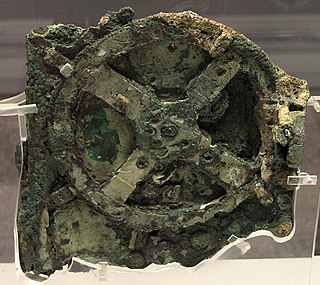 W
WGreek astronomy is astronomy written in the Greek language in classical antiquity. Greek astronomy is understood to include the ancient Greek, Hellenistic, Greco-Roman, and Late Antiquity eras. It is not limited geographically to Greece or to ethnic Greeks, as the Greek language had become the language of scholarship throughout the Hellenistic world following the conquests of Alexander. This phase of Greek astronomy is also known as Hellenistic astronomy, while the pre-Hellenistic phase is known as Classical Greek astronomy. During the Hellenistic and Roman periods, much of the Greek and non-Greek astronomers working in the Greek tradition studied at the Musaeum and the Library of Alexandria in Ptolemaic Egypt.
 W
WThe Antikythera mechanism is an ancient Greek hand-powered orrery, described as the first analogue computer, the oldest known example of such a device used to predict astronomical positions and eclipses for calendar and astrological purposes decades in advance. It could also be used to track the four-year cycle of athletic games which was similar to an Olympiad, the cycle of the ancient Olympic Games.
 W
WAn armillary sphere is a model of objects in the sky, consisting of a spherical framework of rings, centred on Earth or the Sun, that represent lines of celestial longitude and latitude and other astronomically important features, such as the ecliptic. As such, it differs from a celestial globe, which is a smooth sphere whose principal purpose is to map the constellations. It was invented separately in ancient Greece and ancient China, with later use in the Islamic world and Medieval Europe.
 W
WAn astrolabe is an ancient astronomical device that equates to a handheld model of the universe. Its various functions also make it an elaborate inclinometer and an analogue calculation device capable of working out several kinds of problems in astronomy. Historically used by astronomers it is able to measure the altitude above the horizon of a celestial body, day or night; it can be used to identify stars or planets, to determine local latitude given local time, to survey, or to triangulate. It was used in classical antiquity, the Islamic Golden Age, the European Middle Ages and the Age of Discovery for all these purposes.
 W
WAstronomical rings, also known as Gemma's rings, are an early astronomical instrument. The instrument consists of three rings, representing the celestial equator, declination, and the meridian.
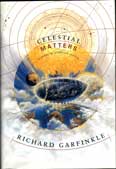 W
WCelestial Matters is a science fantasy novel by American writer Richard Garfinkle, set in an alternate universe with different laws of physics. Published by Tor Books in 1996, it is a work of alternate history and elaborated "alternate science", as the physics of this world and its surrounding cosmos are based on the physics of Aristotle and ancient Chinese Taoist alchemy.
 W
WThe grounds of the Palais des Nations contain many fine objects donated by member states of the United Nations, private sponsors and artists. The Celestial Sphere in the Ariana Park of the Palais des Nations is the best-known of these. The huge - over four meter diameter - Celestial Sphere is the chef d'oeuvre of the American sculptor Paul Manship (1885–1966). It was donated in 1939 by the Woodrow Wilson Foundation to what was then the League of Nations building. Known also as the Woodrow Wilson Memorial Sphere of the Palais des Nations it is today a symbol of Geneva International and of Geneva as the centre of dialogue and peace.
 W
WThe celestial spheres, or celestial orbs, were the fundamental entities of the cosmological models developed by Plato, Eudoxus, Aristotle, Ptolemy, Copernicus, and others. In these celestial models, the apparent motions of the fixed stars and planets are accounted for by treating them as embedded in rotating spheres made of an aetherial, transparent fifth element (quintessence), like jewels set in orbs. Since it was believed that the fixed stars did not change their positions relative to one another, it was argued that they must be on the surface of a single starry sphere.
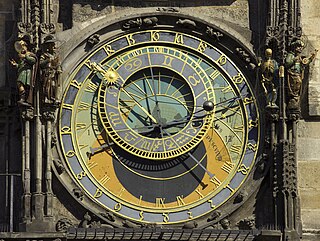 W
WAn astronomical clock, horologium, or orloj is a clock with special mechanisms and dials to display astronomical information, such as the relative positions of the sun, moon, zodiacal constellations, and sometimes major planets.
 W
WAncient, medieval and Renaissance astronomers and philosophers developed many different theories about the dynamics of the celestial spheres. They explained the motions of the various nested spheres in terms of the materials of which they were made, external movers such as celestial intelligences, and internal movers such as motive souls or impressed forces. Most of these models were qualitative, although a few of them incorporated quantitative analyses that related speed, motive force and resistance.
 W
WEquant is a mathematical concept developed by Claudius Ptolemy in the 2nd century AD to account for the observed motion of the planets. The equant is used to explain the observed speed change in different stages of the planetary orbit. This planetary concept allowed Ptolemy to keep the theory of uniform circular motion alive by stating that the path of heavenly bodies was uniform around one point and circular around another point.
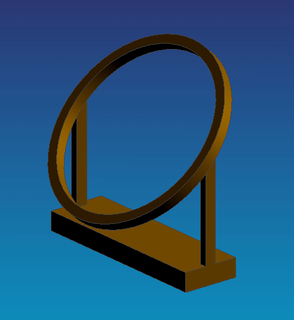 W
WAn equatorial ring was an astronomical instrument used in the Hellenistic world to determine the exact moment of the spring and autumn equinoxes. Equatorial rings were placed before the temples in Alexandria, in Rhodes, and perhaps in other places, for calendar purposes.
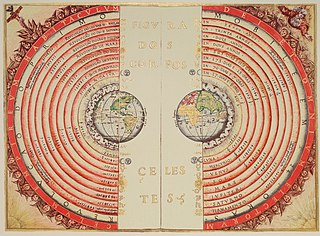 W
WIn astronomy, the geocentric model is a superseded description of the Universe with Earth at the center. Under the geocentric model, the Sun, Moon, stars, and planets all orbited Earth. The geocentric model was the predominant description of the cosmos in many ancient civilizations, such as those of Aristotle in Classical Greece and Ptolemy in Roman Egypt.
 W
WA gnomon is the part of a sundial that casts a shadow. The term is used for a variety of purposes in mathematics and other fields.
 W
WHeliocentrism is the astronomical model in which the Earth and planets revolve around the Sun at the center of the Universe. Historically, heliocentrism was opposed to geocentrism, which placed the Earth at the center. The notion that the Earth revolves around the Sun had been proposed as early as the 3rd century BC by Aristarchus of Samos, but at least in the medieval world, Aristarchus' heliocentrism attracted little attention—possibly because of the loss of scientific works of the Hellenistic period.
 W
WThe Metonic cycle or enneadecaeteris is a period of approximately 19 years after which the phases of the moon recur on the same day of the year. The recurrence is not perfect, and by precise observation the Metonic cycle is defined as 235 synodic lunar months, a period which is just 1h27m33s longer than 19 tropical years. Meton of Athens judged the cycle to be a whole number of days, 6,940. Using these integer numbers facilitates the construction of a luni-solar calendar.
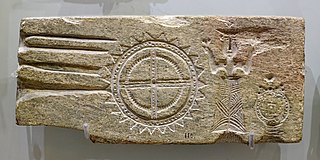 W
WThe Minoan Moulds of Palaikastro are double sided schist casting moulds from the time of the Minoan culture for casting cultural figurines and symbols. These include female figurines with raised arms, double axes and opium poppy flowers or capsules, two double axes with indented edges, "sanctification horns" and a geared disc with a cross and astral symbols, which could have been used for astronomical predictions of solar and lunar eclipses. They have been found near Palaikastro in the eastern part of Crete.
 W
WA mural instrument is an angle measuring device mounted on or built into a wall. For astronomical purposes, these walls were oriented so they lie precisely on the meridian. A mural instrument that measured angles from 0 to 90 degrees was called a mural quadrant. They were utilized as astronomical devices in ancient Egypt and ancient Greece. Edmond Halley, due to the lack of an assistant and only one vertical wire in his transit, confined himself to the use of a mural quadrant built by George Graham after its erection in 1725 at the Royal Observatory, Greenwich. Bradley's first observation with that quadrant was made on 15 June 1742.
 W
WAn astronomical system positing that the Earth, Moon, Sun and planets revolve around an unseen "Central Fire" was developed in the 5th century BC and has been attributed to the Pythagorean philosopher Philolaus. The system has been called "the first coherent system in which celestial bodies move in circles", anticipating Copernicus in moving "the earth from the center of the cosmos [and] making it a planet". Although its concepts of a Central Fire distinct from the Sun, and a nonexistent "Counter-Earth" were erroneous, the system contained the insight that "the apparent motion of the heavenly bodies" was due to "the real motion of the observer". How much of the system was intended to explain observed phenomena and how much was based on myth and religion is disputed. While the departure from traditional reasoning is impressive, other than the inclusion of the 5 visible planets, very little of the Pythagorean system is based on genuine observation. In retrospect, Philolaus's views are "less like scientific astronomy than like symbolical speculation."
 W
WThe scaphe was a sundial said to have been invented by Aristarchus of Samos. There are no original works still in existence by Aristarchus, but the adjacent image is an image of what it might have looked like; only his would have been made of stone. It consisted of a hemispherical bowl which had a vertical gnomon placed inside it, with the top of the gnomon level with the edge of the bowl. Twelve gradations inscribed perpendicular to the hemisphere indicated the hour of the day.
 W
WThe earliest documented mention of the spherical Earth concept dates from around the 5th century BC, when it was mentioned by ancient Greek philosophers. In the 3rd century BC, Hellenistic astronomy established the roughly spherical shape of the Earth as a physical fact and calculated the Earth's circumference. This knowledge was gradually adopted throughout the Old World during Late Antiquity and the Middle Ages. A practical demonstration of Earth's sphericity was achieved by Ferdinand Magellan and Juan Sebastián Elcano's circumnavigation (1519–1522).
 W
WThe triquetrum was the medieval name for an ancient astronomical instrument first described by Ptolemy in the Almagest. Also known as Parallactic Rulers, it was used for determining altitudes of heavenly bodies. Ptolemy calls it a "parallactic instrument" and seems to have used it to determine the zenith distance and parallax of the Moon.
 W
WUrania was, in Greek mythology, the muse of astronomy, and in later times, of Christian poetry.